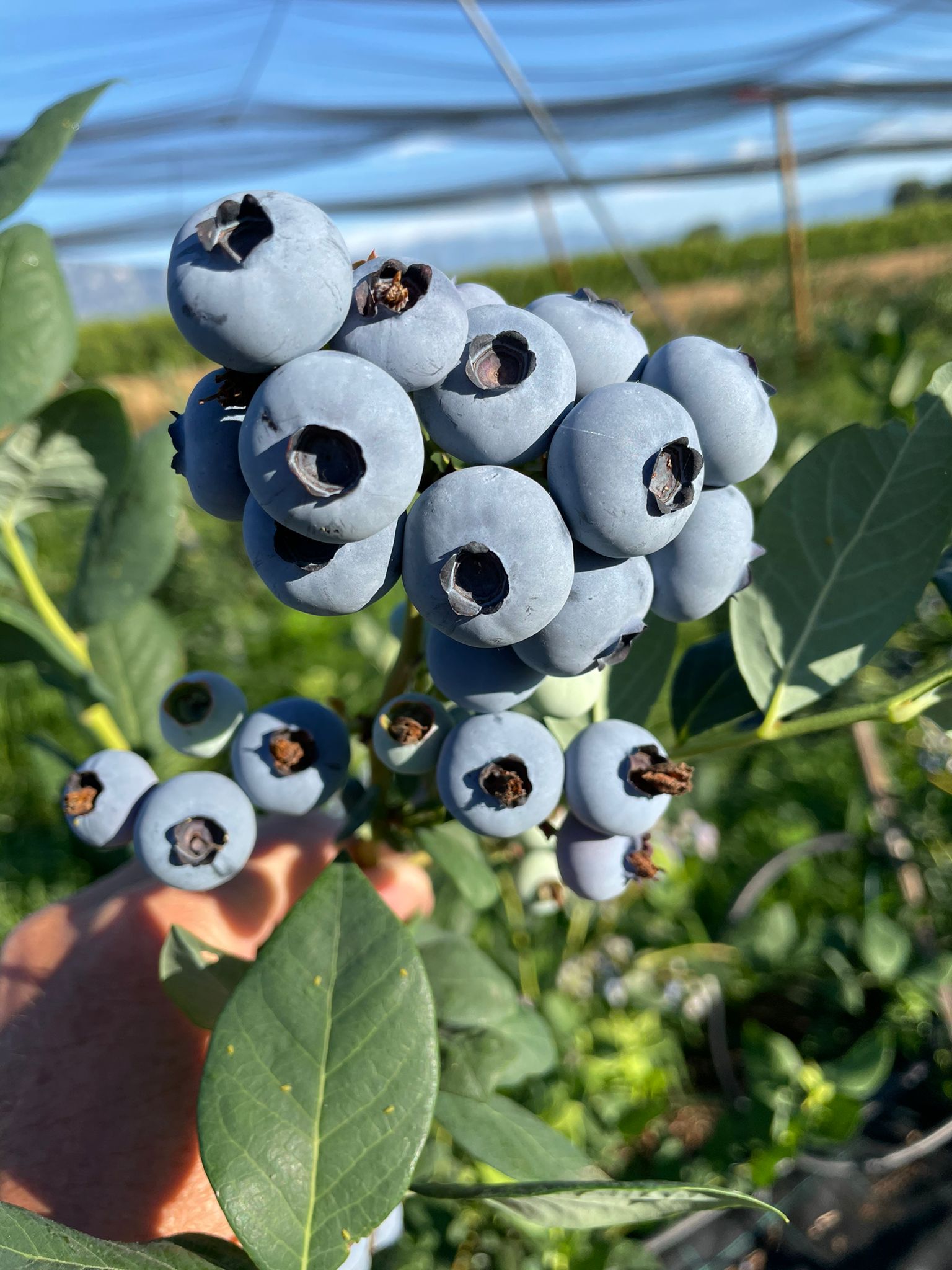The blackberry and raspberry are classified as an aggregate fruit, this means that each drupeola is actually a fruit and thus the set of drupeolae form the blackberry or raspberry fruit. In the case of raspberry, the floral receptacle remains on the plants and the integrity of the fruit is maintained by the presence of small hairs that keep the fruit well assembled after its removal/harvesting. In blackberries the receptacle is harvested with the fruit, maintaining its integrity.

Figure 1. Structure of raspberry fruits and blackberries. In sequence, 1 = Fruit Aggregate, 2 = Sepal, 3 = Pedunculus, 4 = Floral Receptacle, 5 = Drupeole, 6 = Seed. Drawing: https://it.dreamstime.com
Among the different berries, raspberries and blackberries are the most delicate ones; they are naturally soft, sensitive to heat and temperature changes. They have a high respiration rate and a very thin skin, so harvesting and post-harvest storage operations must be carried out gently, precisely and respecting the needs of the varieties.
Summary
COLLECTION
COLLECTION HOURS
Raspberries should ideally be harvested every day in the early hours of the morning, ideally finishing the harvest between 10:00 and 10:30.
HYGIENE
Staff carrying out the picking operation should wash their hands before starting to pick fruit and maintain a high level of hygiene during the activity.
COLLECTION POINT
The fruit must be picked at the ideal point of ripeness to ensure taste and quality.
Some varieties do not detach easily from the receptacle when the fruit is not fully ripe; part of the fruit may remain attached to the receptacle, causing the fruit to break. In this case, harvesting should be done when the fruit is fully ripe so as not to damage it.


Figure 2. Harvest detail, 2.A = fruit easy to harvest - detaches well from the receptacle, 2.B = fruit difficult to harvest - does not detach well from the receptacle. Photo: Molari Berries & Breeding, Daniela Segantini.
Raspberries are considered to be non-climacteric fruits, which means that they must be picked at or near full maturity, as the fruit will not continue to ripen once it is removed from the plant. In some cases, they may change colour during storage, but if they are picked too early, the texture, juiciness and sweetness will not develop fully during storage, not giving the appropriate qualities to the fruit that will be consumed. For an acceptable level of flavour, a minimum of 7% Brix and/or a maximum acidity of 0.8% is recommended.
So, ultimately, picking fruit too early generally results in a raspberry that is too acidic and dry, i.e. not juicy enough. Picking a fruit that is too ripe, on the other hand, can shorten its shelf life in the fridge and increase the likelihood of mould development, loss of juice and other characteristics that are not appropriate for good quality.
When the final destination of the fruit is more distant markets and the fruit has to "travel" for a long time, it can be harvested at an earlier stage of ripeness, but always close to the ideal ripening point to guarantee the organoleptic characteristics. On the other hand, when the final destination is the local market, the fruit can be harvested when fully ripe, but never overripe.


Figure 3. Different ripening stages of raspberries, 3.A = Ripening point close to ideal - distant markets, 3.B high = Ideal ripening point - local markets, 3.B low = Fruit too ripe. Photo: Molari Berries & Breeding, Daniela Segantini.
PACKAGING
In order to avoid excessive handling and visible damage to the fruit, berries for the fresh market must be hand-picked, sorted, graded and packed in the field, directly into the final container/basket. During harvesting, the fruit should be protected from direct sunlight. Once harvesting is complete, the fruit should be placed in a pre-cooling room/room.
Fruit ripeness at harvest and fruit handling are two critical factors in preserving post-harvest quality. Inadequately ripe fruit may have a longer shelf life, but is unlikely to develop appropriate organoleptic characteristics, while the shelf life of over-ripe fruit is generally very short as it increases susceptibility to decay.
There are various types of baskets and packaging available on the market today to hold raspberries, and many different materials and packaging sizes are available. The type of basket selected by the individual producer depends on the market and consumer preference. As a general rule: choose a suitable container that allows the fruit to breathe properly and do not overlap more than two layers of fruit to avoid crushing and damage.

FRUIT CLASSIFICATION
Fruit may be classified in 1st and 2nd category. Category 1 identifies fruit without defects, i.e. fruit which is firm, of good size, dimension and appropriate colour. Category 2 includes fruit with defects, i.e. small, dark, unevenly coloured, soft, deformed or double fruit. Fruit in the 2nd category could then be destined for processing, industry or processed products such as jams, fruit pulp, juices.


Figure 4.B Harvest detail, 4.B1= Fruit of 1st category - without defects, 4.B2 = Fruit of 2nd category - with defects. Photo: Molari Berries & Breeding, Daniela Segantini.
POST-HARVESTING AND CONSERVATION
PRE-COOLING
Pre-cooling is the rapid removal of heat from the field, and is ideally done within 1-2 hours of harvest. Pre-cooling can be achieved by forced cold air moving rapidly through the fruit pallets to lower the temperature of the fruit to between 0° and +1°C. Forced air is the preferred method, compared to ambient cooling, as forced air can cool the fruit to +1°C within an hour, whereas in a cold store without mechanical intervention cooling can take up to 9 h.
Raspberries must be cooled in forced air to +1°C no later than 12 hours after picking.
CONSERVATION
High relative humidity (90-95%) must be maintained in the cold storage rooms, but the fruit must be kept dry. Moisture on the fruit or in the containers should be reduced to minimum levels, to prevent the fruit from quickly rotting. The ideal storage temperature for fruit is between 0°C and +1°C and never below -0.6°C (freezing point of raspberries). Low temperatures slow down the growth of fungi and, at the same time, reduce the rate of respiration and water loss and thus delay the ripening and senescence processes. Temperatures below 4°C already greatly reduce the development of mould and other diseases that can occur in the post-harvest phase.
TRANSPORT
Transport is the last step, but not the least important. The fruit must be transported in clean, well-maintained trucks and it is essential to keep the fruit cool and protected during loading, unloading and transport. In order to ensure proper circulation of cold air and avoid mechanical damage, the packaging containing the fruit must be transported in stable, well-distributed pallets inside the truck. To avoid mechanical damage caused, for example, by poorly maintained roads, it is good practice to stabilise the load on the pallets. When using refrigerated transport, it is very important to achieve proper cooling of the product before loading. Desired temperature and relative humidity: 0°C and 90-95%.
HOME
Fruit bought from the supermarket, once at home, should be refrigerated and washed only before consumption.
BIBLIOGRAPHY
- Raspberry & Blackberry Harvest & Postharvest Handling 2012 Craig Kahlke, Lake Ontario Fruit Team Available at: https://rvpadmin.cce.cornell.edu/uploads/doc_99.pdf
- Postharvest handling of berries. Sandra Horvitz, Food Science and Engineering Faculty, Technical University of Ambato, Ambato, Ecuador. Available at: https://www.researchgate.net/publication/319692016_Postharvest_Handling_of_Berries
- Fruit Quality of Stored, Fresh Red Raspberries After a Delay in Precooling. Available in: http://www.omafra.gov.on.ca/english/crops/facts/storage_berries.htm
- Postharvest Handling and Storage of Berries. JoAnn Robbins and Patrick P. Moore. HortTechnology Oct/Dec 1992 2(4).
- Protecting Perishable Foods During Transport by Truck. USDA Agricultural Marketing Service Transportation and Marketing Programs. Handbook Number 669,1st Edition 1996,2nd Edition 2005. Available at: https://www.ams.usda.gov/sites/default/files/media/TransportPerishableFoodsbyTruck%5B1%5D.pdf
This content has been developed with the technical support of:










